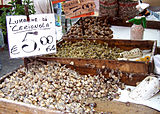| Argopecten purpuratus | |
|---|---|
 | |
| Scientific classification | |
| Domain: | Eukaryota |
| Kingdom: | Animalia |
| Phylum: | Mollusca |
| Class: | Bivalvia |
| Order: | Pectinida |
| Family: | Pectinidae |
| Genus: | Argopecten |
| Species: | A. purpuratus |
| Binomial name | |
| Argopecten purpuratus (Lamarck, 1819) | |
Argopecten purpuratus is an edible marine species of saltwater shellfish, a bivalve mollusc in the family Pectinidae.
